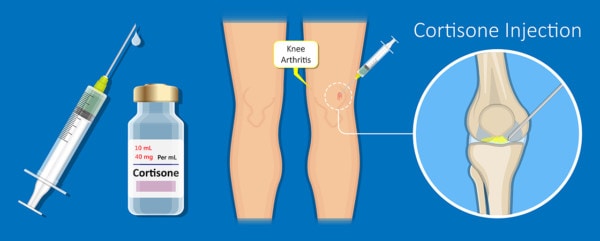More Information that High Dose Steroids Are Bad News for Joints

Rumruay/Shutterstock
One of the most common orthopedic interventions on earth that collectively occurs more times than any other is a steroid injection into a joint. However, we know that these simple procedures harm joints. Despite that, they are still used millions of times each year. Now new research shows that a steroid injection before a meniscectomy surgery is a really bad idea. Let’s dig in.
Why Are Steroids Bad News?
The type of steroids we’re talking about here are corticosteroids and not anabolic steroids. the former are drugs that reduce swelling and inflammation while the latter are those that build muscle.
Your body uses corticosteroid molecules every day to modulate inflammation. However, these are in the nanogram dose range (billionth of a gram). The doses used by 99.9% of physicians that are injected into joints are milligram range (thousandth of a gram). So doctors commonly inject 1,000,000 times too much. Why? It’s medical tradition to use these massive amounts.
What happens when a milligram dose is injected into a joint? First, the natural stem and other repair cells in the joint are wiped out (1). Then the cartilage cells are injured (2). All of that results in loss of cartilage from the joint (3).
Steroids and Joint Infections
We’ve known for some time that a steroid injection in an arthritic joint that later undergoes a replacement procedure will increase the risk of an infected knee or hip joint prosthesis (4-6). Why? While high-dose steroids are potent anti-inflammatories, they also suppress the good side of inflammation, which are cells that help fight infection. With these cells clobbered by the steroids, there is a higher risk that stray bacteria that enter the surgical site can set up shop and grow.
The New Research on Meniscectomy and Steroid Shots
Meniscectomy means cutting out a part of a torn meniscus. While the surgery has largely been discredited as being effective, it’s still one of the most common orthopedic surgeries performed (7-9). Why? Institutional momentum. Meaning that, if most orthopedics practices followed the literature showing that this surgery is no more effective than physical therapy or a fake surgery, many wouldn’t be able to make payroll.
The new research looked at 11,652 patients with and 37,261 without a history of a knee corticosteroid injection within 1 year of arthroscopic meniscectomy (10). The patients who received knee steroid injections within 1 month prior to this surgery developed postoperative infections at twice the rate of those who did not receive an injection. However, those patients who had an injection more than a month after surgery didn’t have any increased rate of infection.
The upshot? We’ve known for some time that common milligram dose steroid injections are bad news for knee joints. Despite that, they are commonly used every day. If you’re a patient considering any kind of surgery, avoid getting a steroid injection. While you’re at it, just skip the steroid injection altogether, your knee will thank you for it.
_________________________________
References:
(1) Wyles CC, Houdek MT, Wyles SP, Wagner ER, Behfar A, Sierra RJ. Differential cytotoxicity of corticosteroids on human mesenchymal stem cells. Clin Orthop Relat Res. 2015 Mar;473(3):1155-64. doi: 10.1007/s11999-014-3925-y. Epub 2014 Sep 4. PMID: 25187334; PMCID: PMC4317436.
(2) Dragoo JL, Danial CM, Braun HJ, Pouliot MA, Kim HJ. The chondrotoxicity of single-dose corticosteroids. Knee Surg Sports Traumatol Arthrosc. 2012 Sep;20(9):1809-14. doi: 10.1007/s00167-011-1820-6. Epub 2011 Dec 21. PMID: 22186921.
(3) McAlindon TE, LaValley MP, Harvey WF, et al. Effect of Intra-articular Triamcinolone vs Saline on Knee Cartilage Volume and Pain in Patients With Knee Osteoarthritis: A Randomized Clinical Trial. JAMA.2017;317(19):1967–1975. doi: 10.1001/jama.2017.5283
(4) Wijn SRW, Rovers MM, van Tienen TG, Hannink G. Intra-articular corticosteroid injections increase the risk of requiring knee arthroplasty. Bone Joint J. 2020 May;102-B(5):586-592. doi: 10.1302/0301-620X.
(5) Richardson SS, Schairer WW, Sculco TP, Sculco PK. Comparison of Infection Risk with Corticosteroid or Hyaluronic Acid Injection Prior to Total Knee Arthroplasty. J Bone Joint Surg Am. 2019 Jan 16;101(2):112-118. doi: 10.2106/JBJS.18.00454.
(6) Ravi B, Escott BG, Wasserstein D, Croxford R, Hollands S, Paterson JM, Kreder HJ, Hawker GA. Intraarticular hip injection and early revision surgery following total hip arthroplasty: a retrospective cohort study. Arthritis Rheumatol. 2015 Jan;67(1):162-8. doi: 10.1002/art.38886.

If you have questions or comments about this blog post, please email us at [email protected]
NOTE: This blog post provides general information to help the reader better understand regenerative medicine, musculoskeletal health, and related subjects. All content provided in this blog, website, or any linked materials, including text, graphics, images, patient profiles, outcomes, and information, are not intended and should not be considered or used as a substitute for medical advice, diagnosis, or treatment. Please always consult with a professional and certified healthcare provider to discuss if a treatment is right for you.
